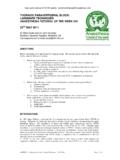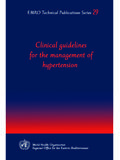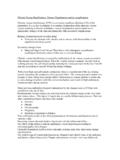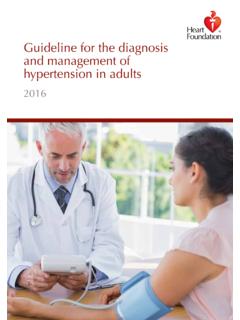Transcription of ANAESTHESIA FOR THE PATIENT WITH …
1 Sign up to receive ATOTW weekly - email ATOTW 228 ANAESTHESIA for the PATIENT with pulmonary hypertension , 20/06/2011 Page 1 of 5 ANAESTHESIA FOR THE PATIENT with pulmonary hypertension ANAESTHESIA TUTORIAL OF THE WEEK 228 20TH JUNE 2011 Dr Sarah Thomas, Senior Anaesthetic Registrar Royal Hobart Hospital Correspondence to QUESTIONS Before continuing, consider the following scenario and question. The answers can be found at the end of the article, together with an explanation. You are to anaesthetise a 65-year-old woman for laparoscopic sigmoid colectomy.
2 She has recently been diagnosed with colorectal carcinoma. The PATIENT has been a heavy smoker in the past and has severe chronic obstructive pulmonary disease (COPD), with secondary pulmonary hypertension . She also has essential hypertension . Medications include a beta-blocker, ACE inhibitor, inhaled steroid/beta-agonist and aspirin. What are your concerns in anaesthetising this PATIENT ? INTRODUCTION The disease spectrum of pulmonary hypertension (PH) has received greater interest in the past decade, as specific therapies have been developed and survival has improved.
3 More patients with PH are now presenting for surgery, and this poses a challenge to the anaesthetist. Knowledge of the underlying physiology is paramount in preventing the feared complication of right heart failure. DEFINITION AND CLASSIFICATION pulmonary hypertension is defined as a mean pulmonary artery pressure (PAP) >25mmHg at rest with a pulmonary capillary wedge pressure <12mmHg. pulmonary hypertension is considered moderately severe when mean PAP >35mmHg. Right ventricular failure is unusual unless mean PAP is >50mmHg.
4 The World Health Organisation classifies pulmonary hypertension by aetiology into five groups. The disease, including its classification, was comprehensively reviewed at the 4th World Symposium on pulmonary hypertension in 2008. Table 1: Clinical classification of pulmonary hypertension 1 pulmonary hypertension (PAH) 2 pulmonary hypertension owing to left heart disease 3 pulmonary hypertension owing to lung disease 4 Chronic thromboembolic pulmonary hypertension (CTEPH) 5 pulmonary hypertension with unclear multifactorial mechanisms Sign up to receive ATOTW weekly - email ATOTW 228 ANAESTHESIA for the PATIENT with pulmonary hypertension , 20/06/2011 Page 2 of 5 Group 1 includes the disease idiopathic pulmonary hypertension (formerly known as primary pulmonary hypertension ), as well as PH associated with connective tissue disorders.
5 This group of diseases share similar pathological findings and clinical appearance. The incidence of idiopathic PH is higher than previously thought, although remains relatively rare at 15 per million. Of greater interest to the anaesthetist are the more common forms of PH: those due to left heart disease (group 2) and those due to lung disease (group 3). Cardiac anaesthetists have long been familiar with PH due to left heart disease, which often occurs in patients undergoing cardiac surgery. Examples would include patients with mitral valve disease undergoing valve replacement, or patients with severe LV failure undergoing coronary bypass surgery.
6 Non-cardiac anaesthetists are more likely to encounter PH in patients with lung disease. Underlying diseases include COAD, interstitial lung disease, and sleep disordered breathing. The majority of patients in this group have modest PH. PITFALLS IN DIAGNOSIS pulmonary hypertension may be suspected after PATIENT assessment based on history, examination, ECG and chest x-ray. The symptoms of PH are non-specific, and diagnosis can be delayed. If PH is suspected, transoesophageal echocardiography (TTE) is usually the first investigation undertaken.
7 TTE utilizes Doppler across a tricuspid regurgitant jet, to estimate pulmonary artery pressure. This technique has been shown to under or over estimate PAP in up to half of patients at risk of PH, and therefore as a diagnostic test has limitations in accuracy. Right heart catheterization is required to confirm the diagnosis. A vasodilator challenge forms part of this assessment. UNDERSTANDING THE PHYSIOLOGY Providing ANAESTHESIA to patients with PH poses some challenges. An underlying knowledge of the cardiovascular pathophysiology is paramount to providing safe ANAESTHESIA in these patients .
8 Right ventricular output is dependent on preload, afterload, contractility and heart rate. Consideration must be given to optimizing each of these parameters. Raised pulmonary vascular resistance (PVR) places an additional pressure load on the right ventricle. The right heart is poorly designed to deal with these increases in afterload. A rise in PVR and hence right ventricular afterload can put the right heart into failure. Left ventricular failure can then ensue, due to both reduced volume reaching the left heart, and septal interdependence.
9 Factors which can raise PVR include hypoxia, hypercarbia, hypothermia, acidaemia, and pain. Anaesthetic technique is aimed at preventing these occurrences. The coronary circulation to the right heart is dependent on perfusion pressure at the aortic root, which in turn is dependent on cardiac output and systemic vascular resistance (SVR). Sign up to receive ATOTW weekly - email ATOTW 228 ANAESTHESIA for the PATIENT with pulmonary hypertension , 20/06/2011 Page 3 of 5 SVR must be aggressively defended in order to maintain coronary perfusion to the right heart.
10 Ischaemia to the right ventricle can put in place a downward spiral of right heart failure, with ensuing cardiovascular collapse. ANAESTHETIC TECHNIQUES Many anaesthetic techniques have been employed in anaesthetising patients with pulmonary hypertension . The actual technique chosen is probably less important than the manner in which it is executed. Extended monitoring will be useful. Invasive blood pressure monitoring is ideal as it will aid early and aggressive treatment of systemic hypotension. A pulmonary artery catheter can be useful in monitoring trends in PAP.















